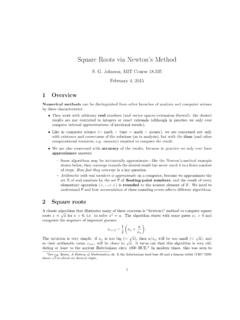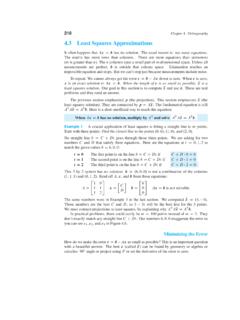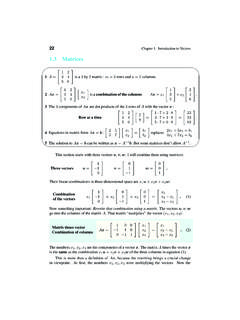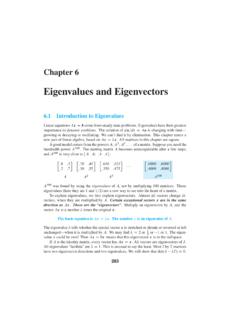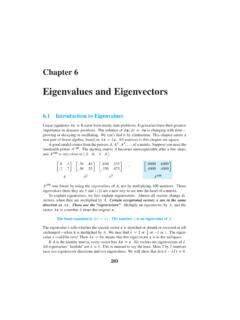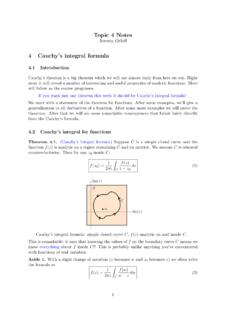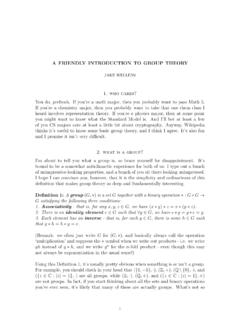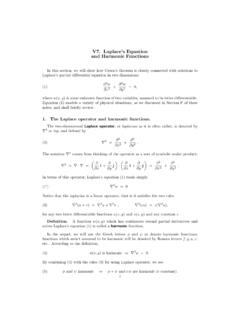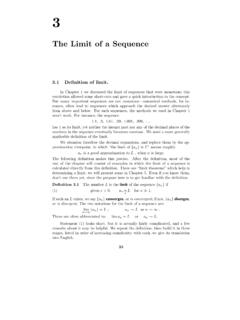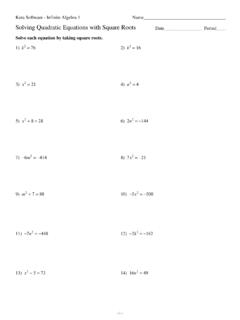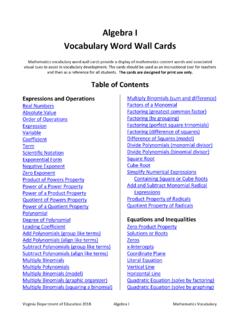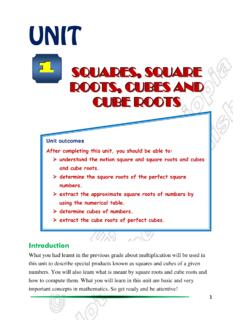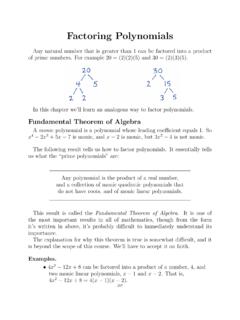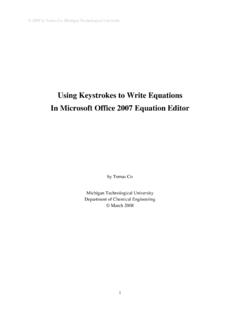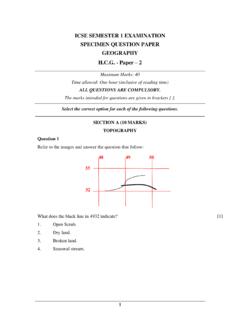Transcription of 1 Complex algebra and the complex plane
1 Topic 1 NotesJeremy Orloff1 Complex algebra and the Complex planeWe will start with a review of the basic algebra and geometry of Complex numbers. Mostlikely you have encountered this previously in or MotivationThe equationx2= 1 has no real solutions, yet we know that this equation arises naturallyand we want to use its roots. So we make up a new symbol for the roots and call it acomplex symbols iwill stand for the solutions to the equationx2= 1. We willcall these new numbers Complex numbers. We will also write 1 = iNote: Engineers typically usejwhile mathematicians and physicists usei. We ll follow themathematical custom in numberiis called animaginary number. This is a historical term. These areperfectly valid numbers that don t happen to lie on the real number re going tolook at the algebra , geometry and, most important for us, the exponentiation of starting a systematic exposition of Complex numbers, we ll work a simple the equationz2+z+ 1 = :We can apply the quadratic formula to getz= 1 1 42= 1 32= 1 3 12= 1 :Do you know how to solve quadratic equations by completing the square ?
2 This ishow the quadratic formula is derived and is well worth knowing! Fundamental theorem of algebraOne of the reasons for using Complex numbers is because allowing Complex roots meansevery polynomial has exactly the expected number of roots. This is called the fundamentaltheorem of motivation for using Complex numbers isnotthe same as the historical motivation. Historically,mathematicians were willing to sayx2= 1 had no solutions. The issue that pushed them to accept complexnumbers had to do with the formula for the roots of cubics. Cubics always have at least one real root , andwhen square roots of negative numbers appeared in this formula, even for the real roots, mathematicianswere forced to take a closer look at these (seemingly) exotic Complex algebra AND THE Complex PLANE2 Fundamental theorem of polynomial of degreenhas exactlyncomplexroots, where repeated roots are counted with a few weeks, we will be able to prove this theorem as a remarkably simple consequenceof one of our main Terminology and basic arithmeticDefinitions Complex numbersare defined as the set of all numbersz=x+yi,wherexandyare real numbers.
3 We denote the set of all Complex numbers byC. (On the blackboard we will usuallywriteC this font is calledblackboard bold.) We callxthereal partofz. This is denoted byx= Re(z). We callytheimaginary partofz. This is denoted byy= Im(z).Important:The imaginary part ofzis areal number. Itdoes notinclude basic arithmetic operations follow the standard rules. All you have to remember isthati2= 1. We will go through these quickly using some simple examples. It almost goeswithout saying that in it is essential that you become fluent with these manipulations. Addition:(3 + 4i) + (7 + 11i) = 10 + 15i Subtraction:(3 + 4i) (7 + 11i) = 4 7i Multiplication:(3 + 4i)(7 + 11i) = 21 + 28i+ 33i+ 44i2= 23 + we have used the fact that 44i2= talking about division and absolute value we introduce a new operation called con-jugation.
4 It will prove useful to have a name and symbol for this, since we will use conjugationis denoted with a bar and defined byx+iy=x +iythen its conjugate isz=x iyand we read this as z-bar =x iy .Example + 5i= 3 following is a veryuseful property of conjugation: Ifz=x+iythenzz= (x+iy)(x iy) =x2+ Complex algebra AND THE Complex PLANE3 Note thatzzis real. We will use this property in the next example to help with (Division.)Write3 + 4i1 + 2iin the standard formx+ :We use the useful property of conjugation to clear the denominator:3 + 4i1 + 2i=3 + 4i1 + 2i 1 2i1 2i=11 2i5=115 the next section we will discuss the geometry of Complex numbers, which give someinsight into the meaning of the magnitude of a Complex number.
5 For now we just give the Complex numberx+iyis defined as|z|= x2+ magnitude is also called theabsolute value, norm of 3 + 5i= 9 + 25 = norm is the sum does not include theiand istherefore always The Complex The geometry of Complex numbersBecause it takes two numbersxandyto describe the Complex numberz=x+iywecan visualize Complex numbers as points in thexy- plane . When we do this we call it thecomplex plane . Sincexis the real part ofzwe call thex-axis the real axis. Likewise, they-axis is the imaginary axisImaginary axisrz=x+iy= (x,y)xy Real axisImaginary axisrz=x+iy= (x,y)rz=x iy= (x, y) The triangle inequalityThe triangle inequality says that for a triangle the sum of the lengths of any two legs isgreater than the length of the third Complex algebra AND THE Complex PLANE4 ABCT riangle inequality:|AB|+|BC|>|AC|For Complex numbers the triangle inequality translates to a statement about Complex mag-nitudes.
6 Precisely: for Complex numbersz1,z2|z1|+|z2| |z1+z2|with equality only if one of them is 0 or if arg(z1) = arg(z2). This is illustrated in thefollowing +z2 Triangle inequality:|z1|+|z2| |z1+z2|We get equality only ifz1andz2are on the same ray from the origin, they have thesame Polar coordinatesIn the figures above we have marked the lengthrand polar angle of the vector from theorigin to the pointz=x+iy. These are the same polar coordinates you saw in There are a number of synonyms for bothrand r=|z|= magnitude = length = norm = absolute value = modulus = arg(z) = argument ofz= polar angle ofzAs in you should be able to visualize polar coordinates by thinking about the distancerfrom the origin and the angle with s make a table ofz,rand for some Complex numbers.
7 Notice that is not uniquely defined since we can always add a multiple of 2 to and still be at thesame point in the +bi r 110,2 ,4 ,..Argument = 0, meanszis along thex-axisi1 /2, /2 + 2 ..Argument = /2, meanszis along they-axis1 +i 2 /4, /4 + 2 ..Argument = /4, meanszis along the ray at 45 to thex-axis1 Complex algebra AND THE Complex PLANE5 Real axisImaginary axisi11 +iWhen we want to be clear which value of is meant, we will specify abranchof arg. Forexample, 0 <2 or < . This will be discussed in much more detail in thecoming weeks. Keeping careful track of the branches of arg will turn out to be one of thekey requirements of Complex Euler s FormulaEuler s (pronounced oilers ) formula connects Complex exponentials, polar coordinates, andsines and cosines.
8 It turns messy trig identities into tidy rules for exponentials. We will useit a lot. The formula is the following:ei = cos( ) +isin( ).(1)There are many ways to approach Euler s formula. Our approach is to simply take Equation1 as the definition of Complex exponentials. This is legal, but does not show that it s a gooddefinition. To do that we need to show the ei obeys all the rules we expect of an do that we go systematically through the properties of exponentials and check that theyhold for Complex behaves like a true as expected:deitdt= follows directly from the definition:deitdt=ddt(cos(t) +isin(t)) = sin(t) +icos(t) =i(cos(t) +isin(t)) = 0= 0= cos(0) +isin(0) = usual rules of exponents hold:eiaeib= ei(a+b). 1 complex algebra AND THE Complex relies on the cosine and sine addition eib= (cos(a) +isin(a)) (cos(b) +isin(b))= cos(a) cos(b) sin(a) sin(b) +i(cos(a) sin(b) + sin(a) cos(b))= cos(a+b) +isin(a+b) = ei(a+b).
9 Definition of ei is consistent with the power series for see this we have to recall the power series for ex, cos(x) and sin(x). They areex= 1 +x+x22!+x33!+x44!+..cos(x) = 1 x22!+x44! x66!+..sin(x) =x x33!+x55!+..Now we can write the power series for ei and then split it into the power series for sineand cosine:ei = 0(i )nn!= 0( 1)k 2k(2k)!+i 0( 1)k 2k+1(2k+ 1)!= cos( ) +isin( ).So the Euler formula definition is consistent with the usual power series for convince you that ei behaves like an Complex exponentials and polar formNow let s turn to the relation between polar coordinates and Complex +iyhas polar coordinatesrand . That is, we havex=rcos( ) andy=rsin( ). Thus, we get the important relationshipz=x+iy=rcos( ) +irsin( ) =r(cos( ) +isin( )) =rei.
10 This is so important you shouldn t proceed without understanding. We also record itwithout the intermediate +iy=rei .(2)Becauserand are the polar coordinates of (x,y) we callz=rei the polar form s now verify that magnitude, argument, conjugate, multiplication and division are alleasy to compute from the polar form |ei |= Complex algebra AND THE Complex PLANE7 Proof.|ei |=|cos( ) +isin( )|= cos2( ) + sin2( ) = words, this says that ei is always on the unit circle this is useful to remember!Likewise, ifz=rei then|z|=r. You can calculate this, but it should be clear from thedefinitions:|z|is the distance fromzto the origin, which is exactly the same definition Ifz=rei then arg(z) = . is again the definition: the argument is the polar angle.
